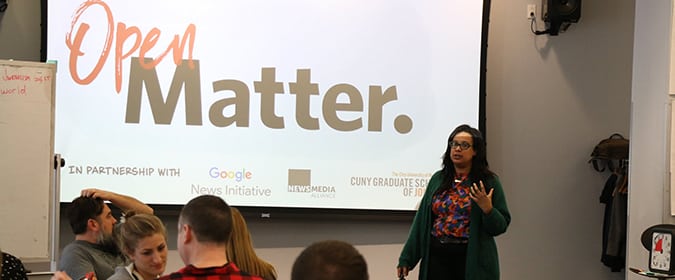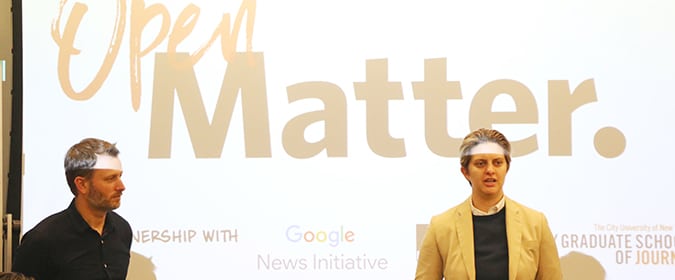
For centuries, consumers got their news solely via printed newspapers. In the past 30 years, however, the media landscape has changed. Now, people can get their news online and on their smartphones. They can watch 24/7 cable TV news, listen to the radio or learn about the world’s goings-on from on-demand podcasts. To keep up, local news outlets must innovate and offer their readers new products that meet their unique needs. That’s where Open Matter comes in.
Last week, the Alliance shared an insider’s view of the inaugural Open Matter local news innovation bootcamp. Open Matter is a partnership between Matter Ventures, Google News Lab and the News Media Alliance that is designed to help local news outlets learn new ways to innovate and bring new products to their audiences — and new revenue to local news.
“Helping local newsrooms navigate the changing media landscape and further grow and innovate is a project we are proud to be a part of,” says Danielle Coffey, the Alliance’s vice president of public policy. “Through this partnership with Matter and Google, the Alliance hopes to offer our member newspapers additional tools and resources to determine the best way to transition content to digital formats and continue to engage the loyal readers of high-quality journalism.”
U.S. partnerships lead for Google News Lab Erica Anderson adds, “We are in a time of transition. While some things never change — like the need for strong ethics, standards and shoe-leather reporting — some things do change — like the skills and mindset to build, iterate and improve new formats of digital news. By partnering with Matter and the News Media Alliance, we can provide strategic and tactical techniques to help newsrooms approach this problem.”
The program is centered on Matter’s approach to innovation and entrepreneurship, known as design thinking. The process focuses first on the end user – on who the audience is and what his or her life looks like. It involves digging deeper than simply asking what they want or need, but looking at what would be useful and meaningful for them in their daily life.

Matter is uniquely qualified to bring these entrepreneurial techniques to newsrooms, in part because the majority of the Matter team involved in Open Matter has some news media background. Many of them got their start in local or investigative reporting, and they know what news producers need to be able to turn a profit. Likewise, they know what news audiences need to be able to trust in their local news source. And they’re excited to be bringing that knowledge to the local newsrooms that participate in Open Matter.
“I feel incredibly privileged that people who are doing important work – journalists – are willing to take three days away in order to acquire new skills and new ways of thinking that they can take back and really put into action,” says Pete Mortensen, Matter’s director of program for their San Francisco office. “We were very mindful of making sure this is worth their while and that they have something really actionable by the end.”
Planning for the takeaways is a big part of what Matter helps participants do, though the takeaway portion of the workshop only comprises a short couple of hours.
“I was blown away by how much they picked up and how they were able to immediately able to start applying [those lessons] to their own work,” Mortensen said of the participants in the first bootcamp. “I couldn’t be happier or more impressed with the group of people that we had, the elasticity of their thinking and their comfort embracing the unknown.”
One of those participants was Phil O’Brien, the publisher of W42ST, a hyperlocal lifestyle magazine that covers the Hell’s Kitchen neighborhood of New York City. When O’Brien rejoined his colleagues after three days with Matter, the W42ST team immediately got to work on a project they’d been working on back at home, including writing a new POV (point-of-view) statement for the product’s user.
“We’d recently built a Facebook chatbot, but [after Open Matter], we were wondering who we really built it for,” O’Brien said. So, he and his coworkers delved deeper into that product when they reconvened. “We’d had the opportunity to chat a bit after class during the week, but at the end of the week we were able to talk about point of view and feedback and flaring and focusing, and we now had a new vocabulary that allowed us to discuss those things more clearly. So, when we got back to work, we were able to communicate better and work more quickly.”
Another participant was Anjanette Delgado, then digital director for lohud.com and now senior news director for digital at the Detroit Free Press. Delgado came into Open Matter with a basic understanding of design thinking, but delving deeper into the full process was a new experience for her.
“Everything we make, we can approach from a design standpoint,” Delgado says. “Whether it’s a story or a project or an app, we can make it better. But for the user at the end, the person who’s going to experience the product, what do they need? How can we best serve them? That’s what I think the real takeaway is. That’s where it all falls into place.”
Delgado also sees how design thinking can come into play in her new newsroom. “I had a question in my head at the start of bootcamp about, ‘Do we do the kind of projects where we can stop and go through the entire [design thinking] process?’ and [the answer is] we do, but we also do smaller projects that can benefit from a piece of the process,” she explains.
As Delgado and O’Brien have already found, there are many ways to apply design thinking to the projects being developed inside local newsrooms. And that’s what the partners behind the Open Matter bootcamp want most.
“The ability to think through [the different elements of design thinking] and not try to do it all simultaneously is a big thing,” Mortensen says. “That, coupled with greater comfort running experiments [in the newsroom] and not trying to get all of the answers or have the perfect [product] at the outset, I think is huge.
“I think the biggest thing, though, is finding little ways to make [design thinking] start showing up on a regular day,” Mortensen continues.
If you want to learn how design thinking can help your newsroom change how it approaches innovation, there’s still time to apply for the final Open Matter bootcamps. You have until May 21, 2018, to get your application in for either the Atlanta, Georgia, bootcamp at James M. Cox Jr. Institute for Journalism Innovation, Management & Leadership at the University of Georgia’s Henry W. Grady College of Journalism and Mass Communication, or the Berkeley, California, bootcamp at UC-Berkeley Advanced Media Institute — apply here.
